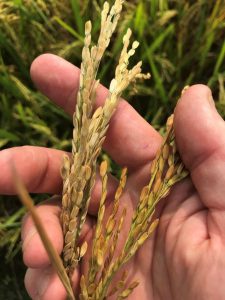During monsoon season, paddy is grown almost in all the cultivated lands of Dhaloguri and Uttar Chakoakheti, two selected villages under ACIAR-LWR project operates in West Bengal. In this year the crop stand is excellent due to continuous receipt of rainfall over last couple of months. In most of the fields the paddy is in heading to harvest stage. In village Dhaloguri (site l), we found the attack of Brown Plant Hopper in some scattered patches which is very serious at this stage of the crop.
Symptoms and nature of damage:
Affected plants dries up and gives a scorched appearance of the plant called Hopper Burn.At early infestation, circular yellow patches appear which soon turn brownish due to rapid drying. The patches of infestation then spread out and cover the entire field very fast. The grain setting is affected to a huge extent and it resulted in a significant yield loss.Both the nymphs and adults remain at ground level and suck the SAP from the plant.
Management strategy:
The problem has to be addressed very quickly. In the village Dhaloguri it is being addressed by the scientists of UBKV to prevent its spread in neighbouring fields.It is now advocated to drain out excess water from the field, if any. Any one of the following systemic insecticides should be applied on urgent basis:
Imidachloprid 17.8%(1ml in 5 litres of water) Thiomethoxam 25%(1 g in 3 litres of water) Acephate 50%+Imidachloprid 1.8%(2 g per litre of water) Cartap hydrochloride 50%(1 g per litre of water) It is being advised from the project to monitor the fields on regular basis so that chemical measures can be taken immediately if symptoms appear in the field.






